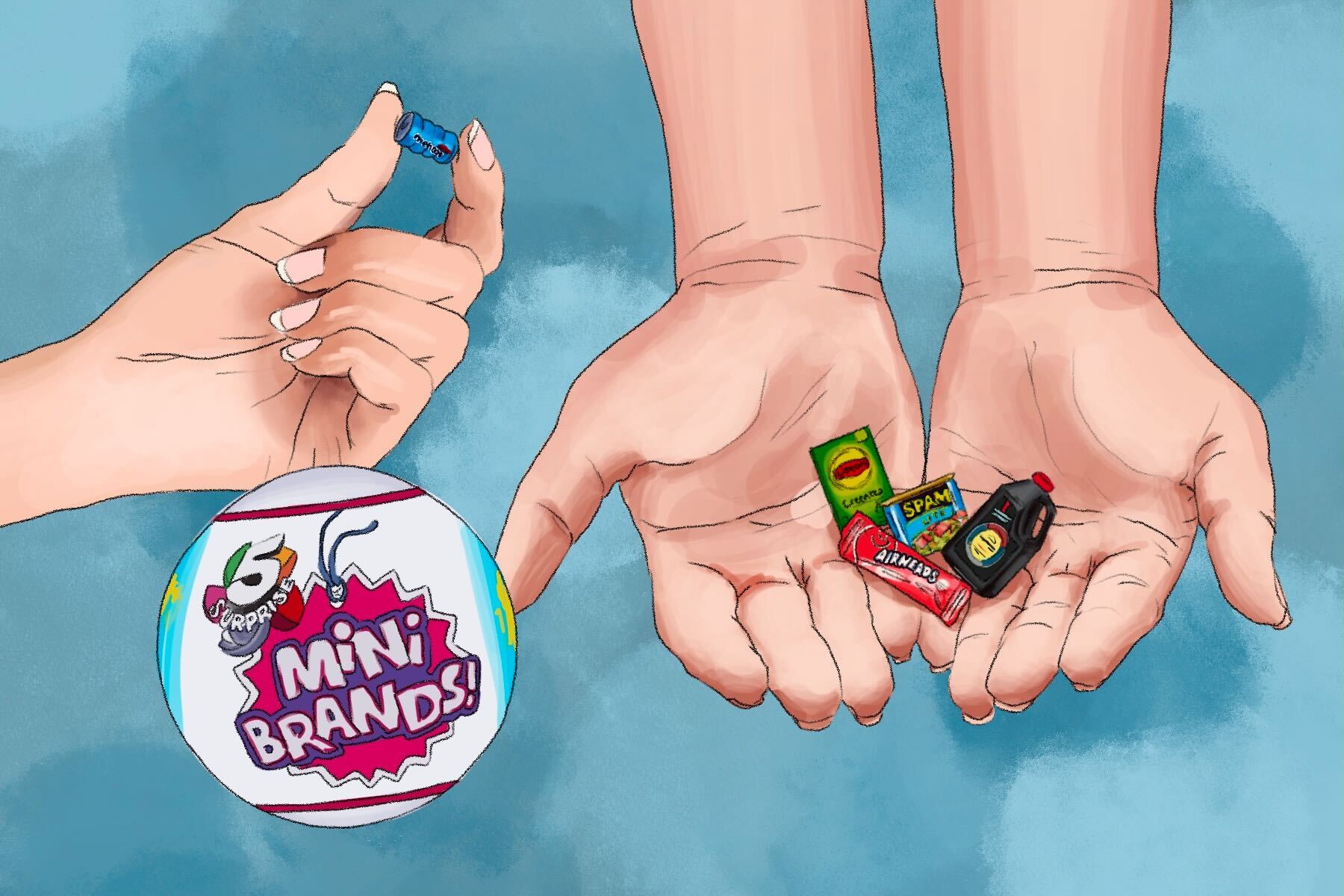Let’s face it: Sometimes it’s hard to stay entertained in our day-to-day lives. Whether it’s picking up a hobby to pass the time or finding new ways to love a daily task, humans wage a constant battle against boredom. For the average person, it’s rare to constantly invest themselves in new activities; it’ll take a little more creativity to bring life back into stale habits. One way to break this cycle is to refresh old hobbies, which can work wonders for motivation at a time when energy is running low. Even in children’s toys, reimagining the possibilities of what’s “cool” can reinvigorate playtime. The climbing success of Zuru’s Mini Brands answers this demand for newness with their trendy twist on toys. These surprise balls transform plain collectibles into loveable miniatures enjoyed by all ages.
The toy giant from New Zealand sells a slew of dolls and games, but their success with the “5 Surprise Mini Brands” has made them a staple of the toy aisle. What’s the secret behind Zuru’s “5 Surprise Mini Brands”? Essentially, the toy mixes together “blind surprise reveals, miniature collectables and the fun of shopping” in a palm-sized prize. Simply referred to as “Mini Brands” by all their fans, the toy is a plastic sphere filled with five compartments with random prizes. However, the hidden goodies in these segmented sensations are unusually common: Each sphere contains miniature versions of brand-name household and grocery products. Everything from cleaning bottles to pasta, candy bars and pantry goods, the Mini Brands are miniature versions of iconic merchandise found in a typical supermarket.
Since their debut in 2019, Mini Brands have been flying off shelves faster than the labels they mimic. Taking recognizable products and miniaturizing them — such as a box of Twinkies or a bottle of Kraft Heinz ketchup — unlocks a world of entertainment for kids and kids-at-heart. The variety of playtime options with the tiny treasures also couples with the variety of miniaturized brands available to scratch that collector’s itch.
As with any collectible toy, Mini Brands also offer rare and hard-to-find figurines. For example, within the 70+ brands in the “Series 1” collection were special gold, metallic and glow-in-the-dark versions of the figurines to hunt for. Today, there are hundreds of items to discover in Mini Brands surprise toys, with more added with each “series” released. By outfitting one’s collection with a play shop that looks like a grocery store aisle or adoring a set of brands from a display case, the audience can jump on the Mini Brand craze in multiple ways.
While the concept of Mini Brands is questionable — collecting miniaturized grocery items is a niche interest — there’s no questioning the size of its booming fanbase. Shortly after the Mini Brands “Series 1” was released, the toy jumped in popularity thanks to fans sharing their prizes on social media. Videos of people unwrapping the toys found success on TikTok, even among those who don’t own the physical Mini Brands. According to a 2019 Insider article, the #MiniBrands hashtag had around 393 million views during its debut year. In comparison, today’s tag of “#minibrands” on TikTok has collected a whopping 3 billion views.
How did this product gain so much media traction after only a few years on the toy market? In a Slate article on “The Gigantic Joy of Collecting Teeny-Tiny Things,” one of the key factors that has sparked Mini Brands’ success is a double threat of combining “the power of collectibles with the unboxing fad.” Because the toy is an excitingly random mixture of nationwide names, Mini Brands are enticing to both the casual consumer and the more extreme collector.
The nature of Mini Brands as “surprise” toys also reveals a growing desire to know what’s inside the ball. Many users swarm TikTok to film short clips of themselves opening a brand new prize ball and showing off the unexpected goodies tucked inside. Whether they win a shrunken box of animal crackers or a tiny-but-rare golden Mentos, each product is a happy addition to growing collections. The sheer joy that the “unboxing” videos hold is present throughout; everyone gets a thrill out of seeing what five surprises are waiting inside, even if this is not their first prize ball. Regardless of whether a viewer has multiple Mini Brands or none, the excitement contained in these videos is felt through the screen.
Subsequently, the toy’s online popularity phased out Mini Brands’ reputation as only a “children’s toy.” While the Zuru company dominates the kids’ toy market, the Mini Brands internet craze has also grown a largely adult fanbase. In short, the grown-ups are having a blast playing with the surprise toys as well. Maybe it’s due to the fact that adults are the first to smile at the familiar labels or because “everything is infinitely more adorable when it comes in teeny, tiny packaging.”
There’s an unexpected element of nostalgia that just packs a punch with the millennials in the room: The recognizable names of favorite products make the toys sought out by different generations. Though Mini Brands are far from the first toy to make its way to an older demographic — collecting Squishmallows has become popular among millennials — the sentimentality of connecting with the brand names makes the surprise toy more enticing than other trends.
The mundanity of these toys is extremely admirable when juxtaposed with their current popularity. Who would have expected the internet to fall head-over-heels in search of a miniature golden Cold Stone milkshake? It’s easy to give all the credit to TikTok for sparking a fanbase for the miniatures; constantly recording these mystery-filled prizes can’t help but make others curious, and want to buy the product for themselves. However, people constantly return to the Mini Brands due to their teensy tiny size.
Though there is nothing traditionally remarkable about a physical can or box of food, it’s the fact that one can now find a mini version of household favorites that makes it so adored. As The Strategist put it, “Shrink a household’s worth of banal necessities to the size of a snail and you can trick yourself into believing that there’s whimsy in the daily grind.” If a person opens a Mini Brands toy to find a miniature version of their favorite can of soup, a shampoo they use or another essential item inside, it automatically adds “cuteness” to the conventional. What is usually seen as bland now becomes intriguing because it is smaller than its larger counterpart.
That “cute factor” is what helps us find something romantic about these plain products or tedious tasks. After all, Slate recalled that unwrapping Mini Brands toys are “not unlike bringing home a real haul of groceries – the contentment of unpacking everything and putting things in their proper place.” The act of fantasizing a mini version of daily activities helps to project a happier feeling of control over the products that we use each day. In a world that can seemingly change by the hour, having that sort of stability is a grounding comfort.
While the fad of Mini Brands gained momentum between 2019-2020, the toy’s popularity isn’t dying out soon. The 2021 holiday season reaffirmed Mini Brands’ outsized presence in the toy market, appearing on many gift guides across the web. More recently, Zuru’s Mini Brands toys were named “Collectible Toy of the Year” by the 57th Toy Industry Awards. Fitting in everywhere from dollhouses to collectors cases, Mini Brands became the perfect way to elevate tired toys with the familiar. The delight that comes with getting a Mini Brands prize ball to “unwrap, peel and reveal REAL miniature collectibles” never fades, no matter the age.
One could argue that Zuru is simultaneously engaging in product placement by adding brand names to their toys, but the technicalities of reading into the meaning of Mini Brands distract from all the inspiring things they do for kids. Even though the kiddos are squealing over mini cheese wheels and figurines of beans during playtime, Mini Brands remains relevant by adding those familiar items into scenes of their own making. The Zuru company just gains bonus points from exposing an “older kid” millennial audience along the way. The fun of enjoying toys never really dies out, it just finds ways to refresh with the changing times. Maybe a new look on playtime will help break the cycle of boredom once and for all.














